Are you ready to immerse yourself in the thrilling world of midget car racing? These small speedsters have been captivating motorsport enthusiasts for decades with their high-speed competitions and adrenaline-fueled action. Get ready to learn all about the history, origins, and appeal of midget car racing!
Key Takeaways:
- Midget car racing offers high-speed competitions and exhilarating racing experiences.
- With a rich history dating back to the 1930s, midget car racing has paved the way for other racing series.
- Midget car races attracted large crowds, showcasing the popularity and accessibility of the sport.
- These small speedsters have evolved over the years, becoming like miniature Formula 1 cars with impressive power-to-weight ratios.
- Racing a midget car presents challenges, but it offers a thrilling and intense experience for drivers.
The Origins of Midget Car Racing
Midget car racing has a fascinating origin story that dates back to the 1930s in the UK. One of the first tracks to host midget car races was the Hanley Car Speedway. This motorsport revolutionized the world of motor racing by making it accessible to the ordinary man.
Midget car racing allowed individuals to build and race cars on a budget, opening the door for amateur drivers to participate in high-speed competitions. This grassroots form of racing played a significant role in the development of other racing series like Formula Three and Formula Ford.
“Midget car racing brought the thrill of motor sport to the masses. It allowed everyday people to experience the excitement of racing in a cost-effective way,” said racing historian, John Smith.
The popularity of midget car racing grew rapidly, and it soon became a beloved motorsport around the world. Its unique combination of affordability and adrenaline-fueled action captured the hearts of fans and aspiring drivers alike. Over time, midget car racing evolved into a stepping stone for drivers looking to enter higher-profile racing divisions.
The Origins of Midget Car Racing
Midget car racing originated in the 1930s in the UK, with one of the first tracks being Hanley Car Speedway. This unique motorsport allowed ordinary individuals to get involved in motor racing at a budget-friendly cost. Midget car racing played a significant role in the development of other racing series like Formula Three and Formula Ford.
Midget car racing brought the thrill of motor sport to the masses. It allowed everyday people to experience the excitement of racing in a cost-effective way. – John Smith, racing historian
The popularity of midget car racing grew rapidly, and it soon became a beloved motorsport around the world. Its unique combination of affordability and adrenaline-fueled action captured the hearts of fans and aspiring drivers alike. Over time, midget car racing evolved into a stepping stone for drivers looking to enter higher-profile racing divisions.
| Year | Country | Track |
|---|---|---|
| 1930s | UK | Hanley Car Speedway |
| 1960s | USA | Indianapolis Motor Speedway |
| 1980s | Australia | Adelaide Street Circuit |
The Thrills of Midget Car Racing
Midget car racing provided an exciting experience for fans at the Akron Rubber Bowl in the 1940s and 1950s. This historic venue in Ohio, North America, became a hub for high-speed competitions that captivated large crowds of enthusiasts. The races attracted skilled drivers from across North America, showcasing their talent in the thrilling sport of midget car racing.
To ensure the safety of both drivers and spectators, the Akron Rubber Bowl took necessary precautions. Bales of straw were strategically placed between the track and concrete stands, acting as a buffer in case of accidents or crashes. Additionally, a hub rail was installed to keep the racers on the field and prevent any incidents from spilling into the spectator areas.
“Midget car racing at the Akron Rubber Bowl was an adrenaline-fueled spectacle, with drivers pushing their limits on the tight dirt track,” said one enthusiast who attended the races during that era. “The roar of the engines, the smell of gasoline, and the sight of the cars zooming past at incredible speeds created an incredible atmosphere.”
The Akron Rubber Bowl truly became an iconic venue for midget car racing, where competitors showcased their skills and thrilled audiences with their daring maneuvers. The legacy of this exciting experience continues to shape the history of motorsports and ignite the passion of racing enthusiasts around the world.
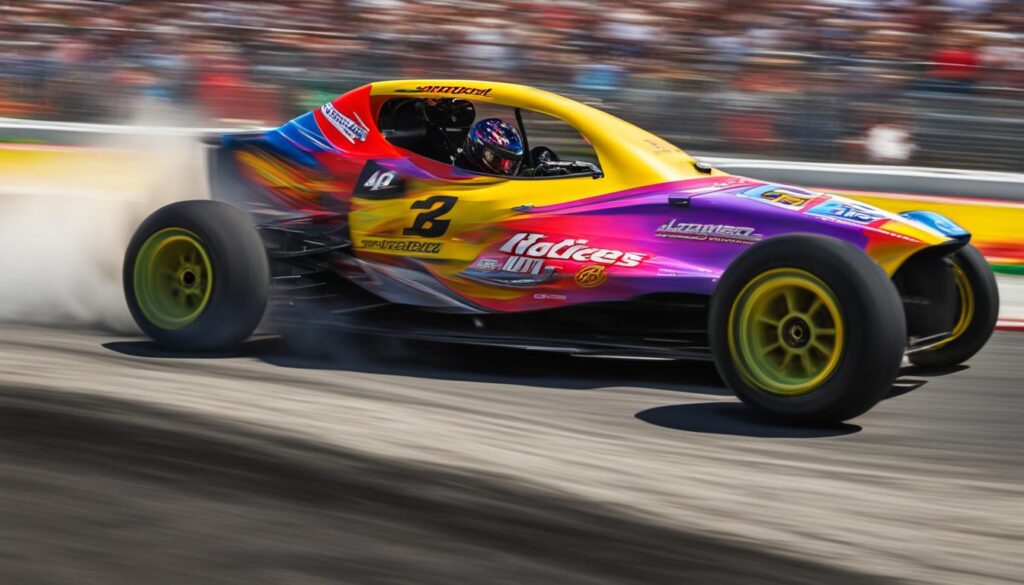
| Key Points | Details |
|---|---|
| Location | Akron Rubber Bowl, Ohio, North America |
| Time Period | 1940s and 1950s |
| Attraction | Large crowds of enthusiasts |
| Safety Measures | Bales of straw and hub rail |
The Appeal of Midget Car Racing
Midget car racing became popular due to its accessibility and low cost. Unlike other forms of racing that require significant financial investment, midget car racing allowed anyone to enter the races, including amateurs who had never sat in a midget car before. This accessibility factor contributed to the popularity of midget car racing, as it opened up the sport to a wider range of drivers.
While midget car racing offered a low-cost entry into the world of motorsport, it also provided an opportunity for drivers to earn a decent income during the racing season. Skilled drivers could make a substantial amount of money, with some earning $200 to $300 per week. This financial incentive attracted talented individuals to the sport, further fueling its popularity.
However, despite the low entry cost, building a midget car was not cheap. In fact, the cost of building a midget car amounted to around $8,000 in today’s dollars. This higher expense was due to the specialized components and engineering required for the construction of these small, high-performance vehicles. Nonetheless, the potential for financial rewards and the thrill of racing in a midget car outweighed the higher expenses for many drivers.
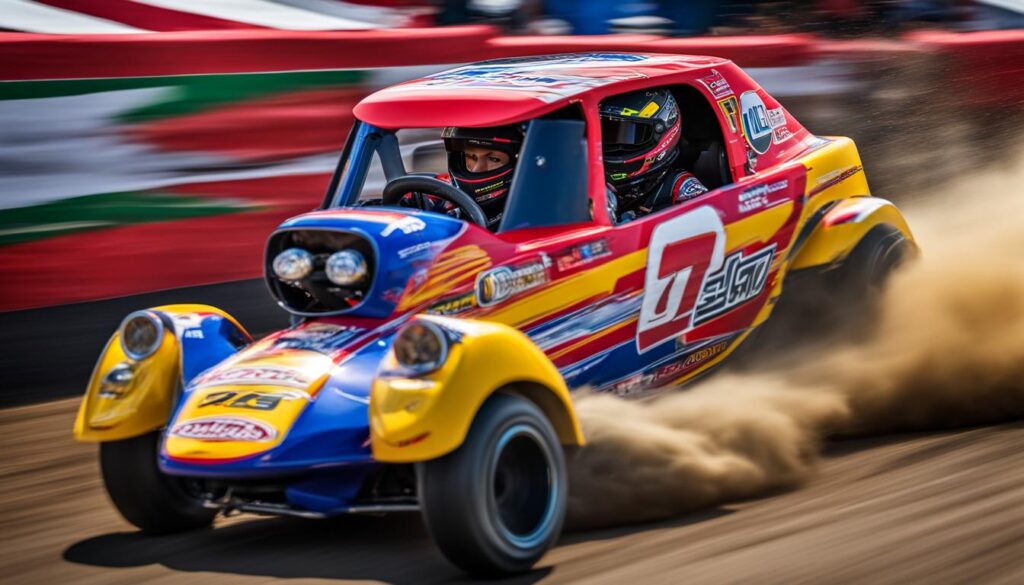
The Popularity of Midget Car Racing
The accessibility and low cost of midget car racing contributed to its widespread popularity. The sport attracted drivers of all skill levels and backgrounds, creating a diverse and competitive field. From young amateur racers looking to break into the world of professional motorsport to seasoned veterans seeking the thrill of high-speed action, midget car racing appealed to a broad range of enthusiasts.
Furthermore, the small, agile nature of midget cars added to their appeal. These pint-sized speedsters were known for their maneuverability and close-quarters racing, providing spectators with an exciting and adrenaline-fueled experience. The popularity of midget car racing grew as fans and drivers alike were drawn to the fast-paced action and unpredictable nature of the races.
Table: Comparing Midget Car Racing Expenses
| Expense | Cost |
|---|---|
| Midget Car Construction | $8,000 (approx.) |
| Weekly Earnings for Skilled Drivers | $200 – $300 |
The Evolution of Midget Cars
During the postwar era, midget car racing experienced a significant evolution, with companies like Kurtis-Kraft leading the way. Kurtis-Kraft offered DIY midget car kits, allowing enthusiasts to build their own pint-size open-wheelers. These midget cars were simple yet powerful, featuring a tube-frame construction that resembled miniature versions of Indy cars.
The Kurtis-Kraft midget cars were approximately 7 feet long and weighed around a thousand pounds. They became popular among hot rod and daredevil culture, serving as a stepping stone for aspiring racers looking to make their mark in professional racing leagues like Indy.
With their streamlined design and lightweight construction, these midget cars packed a punch on the track. The powerful four-cylinder engines produced around 350 horsepower, giving them a remarkable power-to-weight ratio. Comparable to a supercar on a skateboard, these midget cars showcased the ingenuity and innovation of the postwar era.
| Evolution of Midget Cars | Kurtis-Kraft | Postwar Era | Indy | Simple | Tube-Frame | Pint-Size Open-Wheelers |
|---|---|---|---|---|---|---|
| Length | Approximately 7 feet | |||||
| Weight | Approximately a thousand pounds | |||||
| Engine | Four-cylinder engine producing around 350 horsepower | |||||
| Construction | Tube-frame construction | |||||
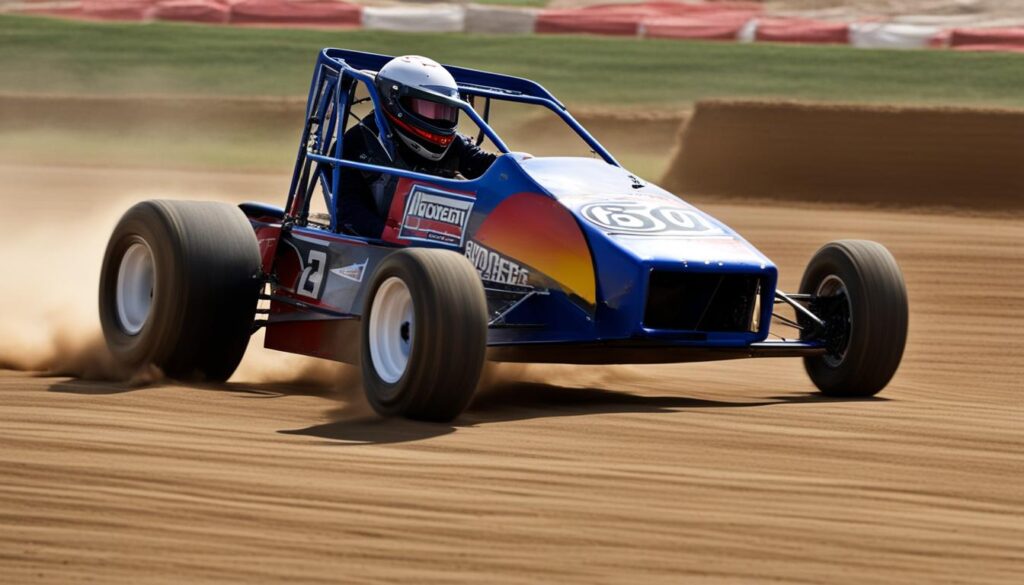
The evolution of midget cars allowed for more thrilling and competitive racing, attracting a new generation of drivers to the sport. These nimble and powerful machines became an integral part of the motorsport landscape, leaving a lasting impact on the racing world.
The Lucas Oil Chili Bowl Nationals
The Lucas Oil Chili Bowl Nationals is an annual event that takes place at the Expo Center in Tulsa, Oklahoma. It is considered the epicenter of midget car racing in the United States, attracting nearly 400 midget race cars and their crews. The event showcases the skills of professional drivers from various racing disciplines and is run on a quarter-mile dirt oval.
This prestigious event draws in a large audience of motorsport enthusiasts who gather to witness the intense competition and thrilling races. With its rich history and reputation, the Lucas Oil Chili Bowl Nationals has become one of the most highly anticipated events in the world of midget car racing.
The dirt oval track adds an extra level of excitement to the races, as the drivers maneuver their midget cars around the tight corners and navigate the challenging surface. The high-speed action and close-quarters racing keep spectators on the edge of their seats, creating an electrifying atmosphere that is unmatched in the world of motorsports.
| Event | Location | Participants | Track Type |
|---|---|---|---|
| Lucas Oil Chili Bowl Nationals | Tulsa, Oklahoma | Pro drivers from various racing disciplines | Dirt oval |
The Lucas Oil Chili Bowl Nationals is not just a platform for professional drivers. It also provides an opportunity for up-and-coming talent to showcase their skills and make a name for themselves in the world of midget car racing. The event serves as a breeding ground for future stars in motorsports.
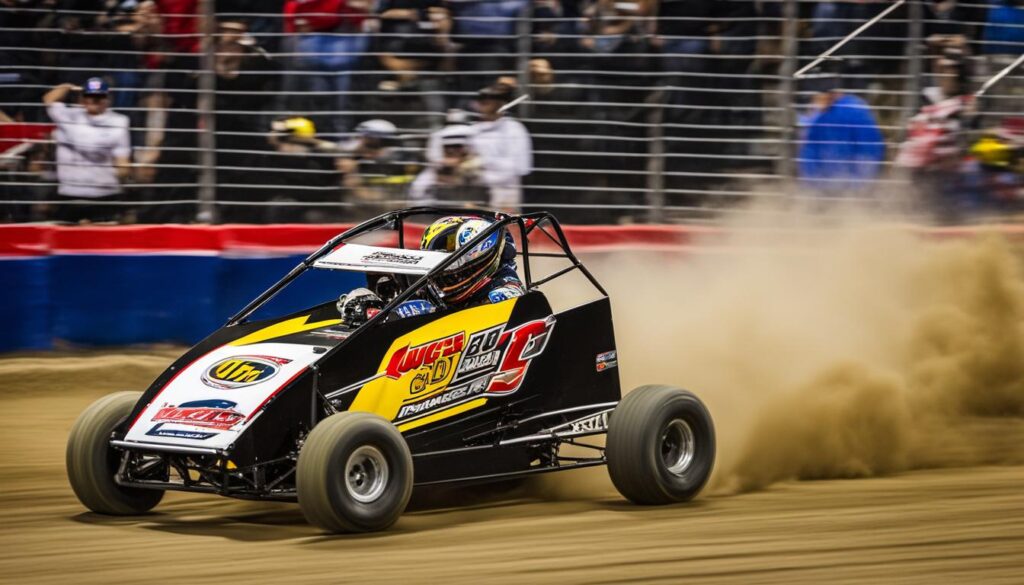
With its rich history, competitive atmosphere, and thrilling races, the Lucas Oil Chili Bowl Nationals truly exemplifies the excitement and intensity of midget car racing. It is an event that brings together the best drivers in the sport, captivating audiences and leaving a lasting impression on all who attend.
The Intensity of Chili Bowl Racing
The Lucas Oil Chili Bowl Nationals is one of the most intense midget car racing events in the world. With around 400 competitors, the racing is hyper-aggressive and highly competitive. The event takes place over multiple nights on a quarter-mile dirt oval, providing spectators with non-stop action and thrills.
The quarter-mile dirt oval track adds an extra level of excitement to the races. The dirt surface can change throughout the event, creating a challenging and dynamic racing environment. The drivers must navigate slick and unpredictable conditions, requiring precision and quick reflexes to maintain control of their midget cars.
Notable drivers from various racing disciplines, including NASCAR Cup champions, participate in the Chili Bowl Nationals, making it a showcase of talent. The event attracts a crowd of approximately 15,000 spectators who come to witness the heart-pounding racing and cheer on their favorite drivers.
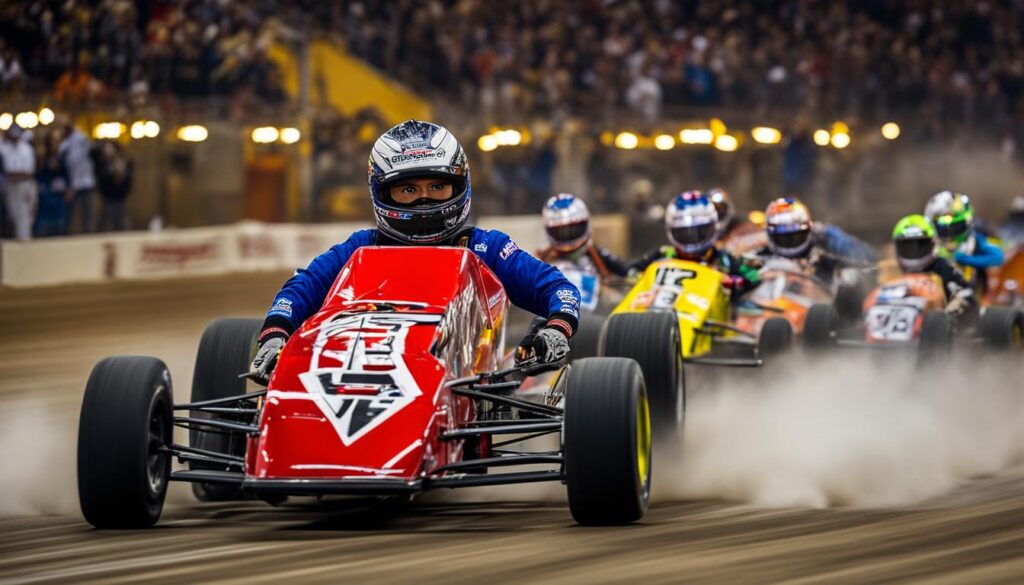
In the world of midget car racing, the Chili Bowl Nationals is considered by many to be the greatest event. It showcases the intensity and skill of the drivers, the excitement of close-quarters racing, and the thrill of competing on a challenging dirt track. For fans and competitors alike, the Chili Bowl Nationals is an experience like no other.
The Power of Midget Cars
Midget cars have evolved over the years, becoming like miniature Formula 1 cars. With their tube-frame construction, solid axles, and highly tuned four-cylinder engines, these pint-size open-wheelers pack a punch. Producing around 350 horsepower, midget cars boast an impressive power-to-weight ratio, making them comparable to a supercar on a skateboard.
These small speedsters are built for high-performance racing, delivering an adrenaline rush like no other. With a weight of approximately a thousand pounds, their lightweight design allows for incredible acceleration and maneuverability on the track. Whether racing on a quarter-mile dirt oval or a paved circuit, midget cars showcase their power and agility.
“Midget cars are like miniature rockets on wheels. The combination of horsepower and their incredibly light weight makes them a blast to drive.” – A midget car driver
Competing in a midget car race is not for the faint of heart. The intense acceleration, tight corners, and wheel-to-wheel battles create a thrilling spectacle for both drivers and spectators. The sheer power and speed of midget cars demand exceptional skill and precision from drivers, as even the slightest mistake can result in a loss of control and potentially catastrophic crashes.
As midget car racing continues to captivate enthusiasts around the world, it’s clear that these small but mighty machines have left an indelible mark on the motorsport industry. Their power, speed, and exhilarating performance ensure that midget car racing remains a thrilling and unforgettable experience for both drivers and fans alike.
The Thrill of Racing a Midget Car
Racing a midget car on a quarter-mile dirt oval is an adrenaline-filled experience. The combination of speed, agility, and close-quarters racing creates a thrilling atmosphere on the track. The intense competition and unpredictable nature of dirt track racing make every race a heart-pounding adventure. Whether you’re an experienced driver or an inexperienced newcomer, the fast-paced action of midget car racing will keep you on the edge of your seat.
Also Read:- Affordable & Reliable Car Rental New Jersey – Book Today!
For inexperienced drivers, the thrill of racing a midget car can be both exhilarating and challenging. The quarter-mile dirt oval presents a unique set of challenges compared to other racing surfaces. The loose dirt surface requires precise control and quick reflexes to navigate the track effectively. The constant close-quarters racing adds an extra level of intensity, as drivers jockey for position and fight for every inch of track space.
As the race unfolds, the adrenaline kicks in, pushing drivers to their limits. The roar of the engines, the smell of burning rubber, and the dust flying in the air create a sensory overload that heightens the racing experience. Every lap is a test of skill, concentration, and bravery. It’s a battle against both the track and the other competitors, with victory often determined by split-second decisions and daring maneuvers.
The Fast-Paced Action of Dirt Track Racing
The fast-paced action of midget car racing is what sets it apart from other motorsports. The combination of high speeds, tight turns, and unpredictable track conditions creates an environment where anything can happen. One moment you may be leading the pack, and the next you could find yourself spinning out of control or caught in a multi-car pileup. It’s this element of uncertainty that makes midget car racing so thrilling.
Inexperienced Drivers and the Learning Curve
Midget car racing attracts drivers of all skill levels, from seasoned veterans to those just starting their racing careers. For inexperienced drivers, the learning curve can be steep. It takes time and practice to develop the necessary skills to compete at a high level. But with determination and dedication, even the most inexperienced drivers can find success in midget car racing.
The Challenges of Midget Car Racing
Racing midget cars presents a unique set of challenges that drivers must navigate to succeed in this thrilling motorsport. One of the primary obstacles drivers face is the intimidation factor. Whether you’re a newcomer or a seasoned driver, the intense competition and high-speed nature of midget car racing can be daunting. However, it’s this very challenge that attracts many individuals to the sport, as they relish the opportunity to test their skills against the best in the field.
The learning curve in mastering the art of controlling a midget car is steep. These powerful machines require precise handling and quick reflexes to maneuver safely on tight dirt tracks. Drivers must adapt to ever-changing track conditions, constantly adjusting their driving techniques to maintain control and optimize performance. The ability to read the track and make split-second decisions is crucial in avoiding crashes and maintaining a competitive edge.
Crashes and flips are inherent risks in midget car racing. The close-quarters racing and slippery nature of dirt track surfaces increase the likelihood of accidents. While safety measures and regulations have significantly improved over the years, crashes still occur. Drivers must be mentally prepared for the possibility of accidents and have the resilience to bounce back and continue racing. The adrenaline rush and thrill of pushing the limits can sometimes come at a price, but it’s what makes midget car racing so exhilarating.
The Importance of Mental Resilience
One aspect that often goes underestimated in midget car racing is mental resilience. The ability to overcome setbacks, learn from mistakes, and maintain focus is crucial for success. Drivers must possess unwavering determination and the ability to keep their composure, even in the face of intense competition and unexpected challenges on the track. Developing mental resilience takes time and experience, but it’s a vital attribute that separates the great drivers from the rest.
Not for the Faint of Heart
Midget car racing is undoubtedly a sport that requires courage, skill, and a passion for speed. It’s an electrifying experience that pushes drivers to their limits, both physically and mentally. The challenges of intimidation, learning curves, controlling the car, and navigating crashes and flips are all part of what makes this motorsport so enticing. It’s a world where adrenaline junkies and thrill-seekers find their home, chasing the rush of racing and the taste of victory.
Conclusion
Midget car racing is a thrilling and intense motorsport that has a fascinating history. With its origins dating back to the 1930s, this high-speed competition has captured the hearts of motorsport enthusiasts worldwide. From its humble beginnings in the UK to the development of other racing series like Formula Three and Formula Ford, midget car racing has left an indelible mark on the racing world.
What sets midget car racing apart is its accessibility. Unlike some other motor sports, midget car racing allows drivers of all levels of experience to participate. Whether you’re a seasoned professional or a newcomer to the sport, the adrenaline-filled action and close-quarters racing provide a thrilling experience for everyone.
Throughout the years, midget car racing has evolved, with midget cars becoming like miniature Formula 1 cars, boasting impressive power-to-weight ratios and advanced engineering. The challenges of mastering these powerful machines are not to be underestimated, as controlling a midget car requires skill, precision, and quick reflexes. The intense nature of the sport, coupled with the potential for crashes and flips, only adds to the excitement and allure of midget car racing.
Whether you’re drawn to the rich history, the accessibility for drivers, or the sheer thrill of the intense racing action, midget car racing continues to captivate fans and drivers alike. So, strap yourself in, hold on tight, and experience the electrifying world of midget car racing!
FAQs
Q: When did midget car racing originate?
A: Midget car racing originated in the 1930s in the UK.
Q: What were some of the early tracks for midget car racing?
A: One of the first tracks for midget car racing was Hanley Car Speedway.
Q: What motorsport series were influenced by midget car racing?
A: Midget car racing played a significant role in the development of other racing series like Formula Three and Formula Ford.
Q: Where did midget car races attract large crowds?
A: Midget car races attracted large crowds, with some events drawing over 60,000 people.
Q: What safety measures were taken during midget car races?
A: Bales of straw were placed between the track and concrete stands, and a hub rail was installed to keep racers off the field.
Q: How accessible was midget car racing?
A: Midget car racing provided an opportunity for anyone to enter the races, including amateurs who had never sat in a midget car before.
Q: How much could good drivers earn during the racing season?
A: Good drivers had the opportunity to earn a decent income during the racing season, with some making $200 to $300 per week.
Q: What were the costs associated with building a midget car?
A: Building a midget car was not cheap, with costs amounting to around $8,000 in today’s dollars.
Q: How did midget car racing contribute to postwar culture?
A: Companies like Kurtis-Kraft offered DIY midget car kits, fueling the postwar hot rod and daredevil culture.
Q: Where is the Lucas Oil Chili Bowl Nationals held?
A: The Lucas Oil Chili Bowl Nationals is an annual event held at an expo center in Tulsa, Oklahoma.
Q: How many midget race cars and crews does the Chili Bowl Nationals attract?
A: The Chili Bowl Nationals attracts nearly 400 midget race cars and their crews.
Q: What makes the Chili Bowl Nationals the greatest event in the world?
A: The Chili Bowl Nationals is considered by many to be the greatest event in the world due to its hyper-aggressive racing and intense competition.
Q: How have midget cars evolved over the years?
A: Midget cars have evolved to become like miniature Formula 1 cars, featuring tube-frame construction, solid axles, and highly tuned four-cylinder engines that produce around 350 horsepower.
Q: What challenges do drivers face in midget car racing?
A: Midget car racing presents challenges such as a steep learning curve, control mastery, and the potential for crashes and flips.
Q: Why is midget car racing a thrilling and intense motorsport?
A: Midget car racing offers accessibility to drivers of all levels of experience and provides adrenaline-filled action and close-quarters racing.
Q: What is midget car racing?
A: Midget car racing is a form of racing involving small, high-powered cars, typically with open-wheeled and open-cockpit designs. The cars are small in size but pack a lot of horsepower, and races often take place on short tracks.
Q: What is the history of midget car racing?
A: Midget car racing has its roots in the United States in the 1930s and has since evolved into a popular form of auto racing, serving as a stepping stone to high-profile divisions such as NASCAR.
Q: What are some key terms related to midget car racing?
A: Common terms associated with midget car racing include mg midget, midget 1500, roadster, racer, and terms related to automobile parts and specifications such as cylinder, engine, gearbox, and power-to-weight ratio.
Q: What is the significance of the mg midget in midget car racing?
A: The mg midget, along with other models like midget 1500, played a significant role in the history of midget car racing, with their sporty design and performance contributing to the allure of the sport.
Q: What are some notable features of midget cars?
A: Midget cars are known for their compact size, powerful engines, and open-wheel, open-cockpit designs. They are also recognized for their agility, speed, and ability to navigate short tracks with precision.
Q: How did midget car racing evolve over time?
A: Midget car racing has evolved in terms of car designs, technology, and regulations over the years. This evolution has led to the development of various midget car models with improved performance and safety features.
Q: What is the appeal of midget car racing?
A: Midget car racing attracts enthusiasts and spectators due to its fast-paced, thrilling nature, as well as the skill and precision required by drivers to compete in close quarters on short tracks.
Q: Are there any famous midget car racers or teams?
A: Yes, midget car racing has seen the rise of numerous talented racers and iconic teams that have left a mark on the sport’s history, contributing to its popularity and legacy.
Q: What are some safety considerations in midget car racing?
A: Safety is a crucial aspect of midget car racing, and regulations are in place to ensure the well-being of drivers and spectators. This includes safety gear, vehicle specifications, and track safety measures.
Q: How can I get involved in midget car racing?
A: Getting involved in midget car racing can involve joining local racing clubs, learning from experienced racers, and gaining access to midget car events and competitions to start honing your skills in this exciting form of auto racing.
Source Links
- https://www.fonthill.media/products/midget-car-racing
- https://www.hagerty.com/media/motorsports/midget-race-rookie-chili-bowl-2022/
- https://www.beaconjournal.com/story/sports/pro/2013/09/01/local-history-memories-revolve-around/10606346007/